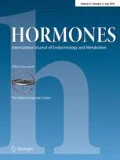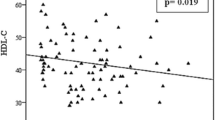Abstract
Purpose
We have recently demonstrated that absolute counts of circulating proinflammatory monocytes were lower in obese patients without metabolic syndrome (MS) (metabolically healthy obese, MHO) compared with those with MS (metabolically unhealthy obese, MUO), but higher compared with healthy lean controls (MHL). We hypothesized that circulating resistin, a cytokine secreted by white blood cells (WBC), is involved in obesity-related low-grade inflammation. The aim of this study was to (a) determine serum resistin levels among MUO and MHO subjects and (b) investigate the role of circulating WBC subsets as potential determinants of resistin.
Methods
Study participants were 58 obese (33 MUO, 25 MHO) and 25 MHL individuals. Serum levels of resistin, high-sensitivity C-reactive protein (hsCRP), and absolute counts of circulating WBC subpopulations were determined. Comparisons were sex- and age-adjusted.
Results
Serum resistin levels in MHL were lower compared with those of obese (p = 0.041), but similar to those of MHO (p = 0.856) individuals. Both resistin (p = 0.005) and absolute neutrophil count (NeuA) (p = 0.025) were higher in MUO compared with MHO. The difference in resistin levels between obese and MHL individuals disappeared after adjustment for NeuA. Resistin correlated positively with absolute total monocyte count (p = 0.037) in MHL and with body mass index (BMI) (p = 0.023), hsCRP (p = 0.022), and NeuA (p = 0.044) in obese subjects. Resistin association with ΒΜΙ disappeared after adjustment for hsCRP, while association with hsCRP disappeared after further adjustment for NeuA.
Conclusion
Circulating resistin was higher in MUO compared with MHO. The increased secretion of resistin by the greater number of neutrophils in the former may have contributed to this regulation.
Similar content being viewed by others
References
Whitlock G, Lewington S, Sherliker P et al (2009) Body-mass index and cause-specific mortality in 900 000 adults: collaborative analyses of 57 prospective studies. Lancet 373:1083–1096
Lassale C, Tzoulaki I, Moons KGM et al (2018) Separate and combined associations of obesity and metabolic health with coronary heart disease: a pan-European case-cohort analysis. Eur Heart J 39:397–406
Weisberg SP, McCann D, Desai M et al (2003) Obesity is associated with macrophage accumulation in adipose tissue. J Clin Invest 112:1796–1808
Phillips CM, Perry IJ (2013) Does inflammation determine metabolic health status in obese and nonobese adults? J Clin Endocrinol Metab 98:E1610–E1619
Christou KA, Christou GA, Karamoutsios A et al (2019) Metabolically healthy obesity is characterized by a proinflammatory phenotype of circulating monocyte subsets. Metab Syndr Relat Disord 17:259–265
Filková M, Haluzík M, Gay S, Senolt L (2009) The role of resistin as a regulator of inflammation: implications for various human pathologies. Clin Immunol 133:157–170
Kunnari AM, Savolainen ER, Ukkola OH et al (2009) The expression of human resistin in different leucocyte lineages is modulated by LPS and TNFalpha. Regul Pept 157:57–63
Boström EA, Tarkowski A, Bokarewa M (2009) Resistin is stored in neutrophil granules being released upon challenge with inflammatory stimuli. Biochim Biophys Acta 1793:1894–1900
Savage DB, Sewter CP, Klenk ES et al (2001) Resistin / Fizz3 expression in relation to obesity and peroxisome proliferator-activated receptor-gamma action in humans. Diabetes 50:2199–2202
Gencer B, Auer R, de Rekeneire N et al (2016) Association between resistin levels and cardiovascular disease events in older adults: the health, aging and body composition study. Atherosclerosis 245:181–186
Muse ED, Feldman DI, Blaha MJ et al (2015) The association of resistin with cardiovascular disease in the Multi-Ethnic Study of Atherosclerosis. Atherosclerosis 239:101–108
Fontana A, Spadaro S, Copetti M et al (2015) Association between resistin levels and all-cause and cardiovascular mortality: a new study and a systematic review and meta-analysis. PLoS One 10:e0120419
Bokarewa M, Nagaev I, Dahlberg L et al (2005) Resistin, an adipokine with potent proinflammatory properties. J Immunol 174:5789–5795
Vassiliadi DA, Tzanela M, Kotanidou A et al (2012) Serial changes in adiponectin and resistin in critically ill patients with sepsis: associations with sepsis phase, severity, and circulating cytokine levels. J Crit Care 27:400–409
Konrad A, Lehrke M, Schachinger V et al (2007) Resistin is an inflammatory marker of inflammatory bowel disease in humans. Eur J Gastroenterol Hepatol 19:1070–1074
Degawa-Yamauchi M, Bovenkerk JE, Juliar BE et al (2003) Serum resistin (FIZZ3) protein is increased in obese humans. J Clin Endocrinol Metab 88:5452–5455
Azuma K, Katsukawa F, Oguchi et al (2003) Correlation between serum resistin level and adiposity in obese individuals. Obes Res 11:997–1001
Silha JV, Krsek M, Skrha JV et al (2003) Plasma resistin, adiponectin and leptin levels in lean and obese subjects: correlations with insulin resistance. Eur J Endocrinol 149:331–335
Magkos F (2019) Metabolically healthy obesity: what's in a name? Am J Clin Nutr 110:533–539
Grundy SM, Cleeman JI, Daniels SR et al (2005) American Heart Association; National Heart, Lung, and Blood Institute. Diagnosis and management of the metabolic syndrome: an American Heart Association/National Heart, Lung, and Blood Institute Scientific Statement. Circulation 112:2735–2752
Levey AS, Stevens LA, Schmid CH et al (2009) CKD-EPI (Chronic Kidney Disease Epidemiology Collaboration). A new equation to estimate glomerular filtration rate. Ann Intern Med 150:604–612
Norata GD, Ongari M, Garlaschelli K et al (2007) Plasma resistin levels correlate with determinants of the metabolic syndrome. Eur J Endocrinol 156:279–284
Qi Q, Wang J, Li H et al (2008) Associations of resistin with inflammatory and fibrinolytic markers, insulin resistance, and metabolic syndrome in middle-aged and older Chinese. Eur J Endocrinol 159:585–593
de Luis DA, Sagrado MG, Conde R et al (2010) Relation of resistin levels with cardiovascular risk factors, insulin resistance and inflammation in naïve diabetes obese patients. Diabetes Res Clin Pract 89:110–114
Osawa H, Tabara Y, Kawamoto R et al (2007) Plasma resistin, associated with single nucleotide polymorphism -420, is correlated with insulin resistance, lower HDL cholesterol, and high-sensitivity C-reactive protein in the Japanese general population. Diabetes Care 30:1501–1506
Aquilante CL, Kosmiski LA, Knutsen SD et al (2008) Relationship between plasma resistin concentrations, inflammatory chemokines, and components of the metabolic syndrome in adults. Metabolism 57:494–501
Mabrouk R, Ghareeb H, Shehab A et al (2013) Serum visfatin, resistin and IL-18 in a group of Egyptian obese diabetic and non diabetic individuals. Egypt J Immunol 20:1–11
Terra X, Auguet T, Quesada I et al (2012) Increased levels and adipose tissue expression of visfatin in morbidly obese women: the relationship with pro-inflammatory cytokines. Clin Endocrinol 77:691–698
Haluzíková D, Lacinová Z, Kaválková P et al (2013) Laparoscopic sleeve gastrectomy differentially affects serum concentrations of FGF-19 and FGF-21 in morbidly obese subjects. Obesity (Silver Spring) 21:1335–1342
Tsai JC, Sheu SH, Chiu HC et al (2007) Association of peripheral total and differential leukocyte counts with metabolic syndrome and risk of ischemic cardiovascular diseases in patients with type 2 diabetes mellitus. Diabetes Metab Res Rev 23:111–118
Lau CH, Muniandy S (2011) Novel adiponectin-resistin (AR) and insulin resistance (IRAR) indexes are useful integrated diagnostic biomarkers for insulin resistance, type 2 diabetes and metabolic syndrome: a case control study. Cardiovasc Diabetol 10:8
Takata Y, Osawa H, Kurata M et al (2008) Hyperresistinemia is associated with coexistence of hypertension and type 2 diabetes. Hypertension 51:534–539
Song G, Wu X, Zhang P et al (2016) High-density lipoprotein inhibits ox-LDL-induced adipokine secretion by upregulating SR-BI expression and suppressing ER stress pathway. Sci Rep 6:30889
Kunnari A, Ukkola O, Päivänsalo M et al (2006) High plasma resistin level is associated with enhanced highly sensitive C-reactive protein and leukocytes. J Clin Endocrinol Metab 91:2755–2756
Burnett MS, Devaney JM, Adenika RJ et al (2006) Cross-sectional associations of resistin, coronary heart disease, and insulin resistance. J Clin Endocrinol Metab 91:64–68
Csongrádi É, Káplár M, Nagy B Jr et al (2017) Adipokines as atherothrombotic risk factors in obese subjects: associations with haemostatic markers and common carotid wall thickness. Nutr Metab Cardiovasc Dis 27:571–580
Furugen R, Hayashida H, Saito T (2013) Porphyromonas gingivalis and Escherichia coli lipopolysaccharide causes resistin release from neutrophils. Oral Dis 19:479–483
Peng Y, Qi Y, Huang F et al (2016) Down-regulated resistin level in consequence of decreased neutrophil counts in untreated Grave’s disease. Oncotarget 7:78680–78687
Liberale L, Bertolotto M, Carbone F et al (2018) Resistin exerts a beneficial role in atherosclerotic plaque inflammation by inhibiting neutrophil migration. Int J Cardiol 272:13–19
Dixon JB, O'Brien PE (2006) Obesity and the white blood cell count: changes with sustained weight loss. Obes Surg 16:251–257
Furuncuoğlu Y, Tulgar S, Dogan AN et al (2016) How obesity affects the neutrophil/lymphocyte and platelet/lymphocyte ratio, systemic immune-inflammatory index and platelet indices: a retrospective study. Eur Rev Med Pharmacol Sci 20:1300–1306
Weber C, Shantsila E, Hristov M et al (2016) Role and analysis of monocyte subsets in cardiovascular disease. Joint consensus document of the European Society of Cardiology (ESC) Working Groups “Atherosclerosis & Vascular Biology” and “Thrombosis”. Thromb Haemost 116:626–637
Author information
Authors and Affiliations
Corresponding author
Ethics declarations
Conflict of interest
The authors declare that they have no conflict of interest.
Ethical approval
All procedures performed in studies involving human participants were in accordance with the 1964 Declaration of Helsinki and its later amendments or comparable ethical standards. The study was approved by the Research Ethics Committee of the University Hospital of Ioannina (13/25-7-2017θ23).
Informed consent
Informed consent was obtained from all individual participants included in the study.
Additional information
Publisher’s note
Springer Nature remains neutral with regard to jurisdictional claims in published maps and institutional affiliations.
Rights and permissions
About this article
Cite this article
Christou, K.A., Christou, G.A., Karamoutsios, A. et al. The regulation of serum resistin levels in metabolically healthy and unhealthy obese individuals. Hormones 19, 523–529 (2020). https://doi.org/10.1007/s42000-020-00201-1
Received:
Accepted:
Published:
Issue Date:
DOI: https://doi.org/10.1007/s42000-020-00201-1




